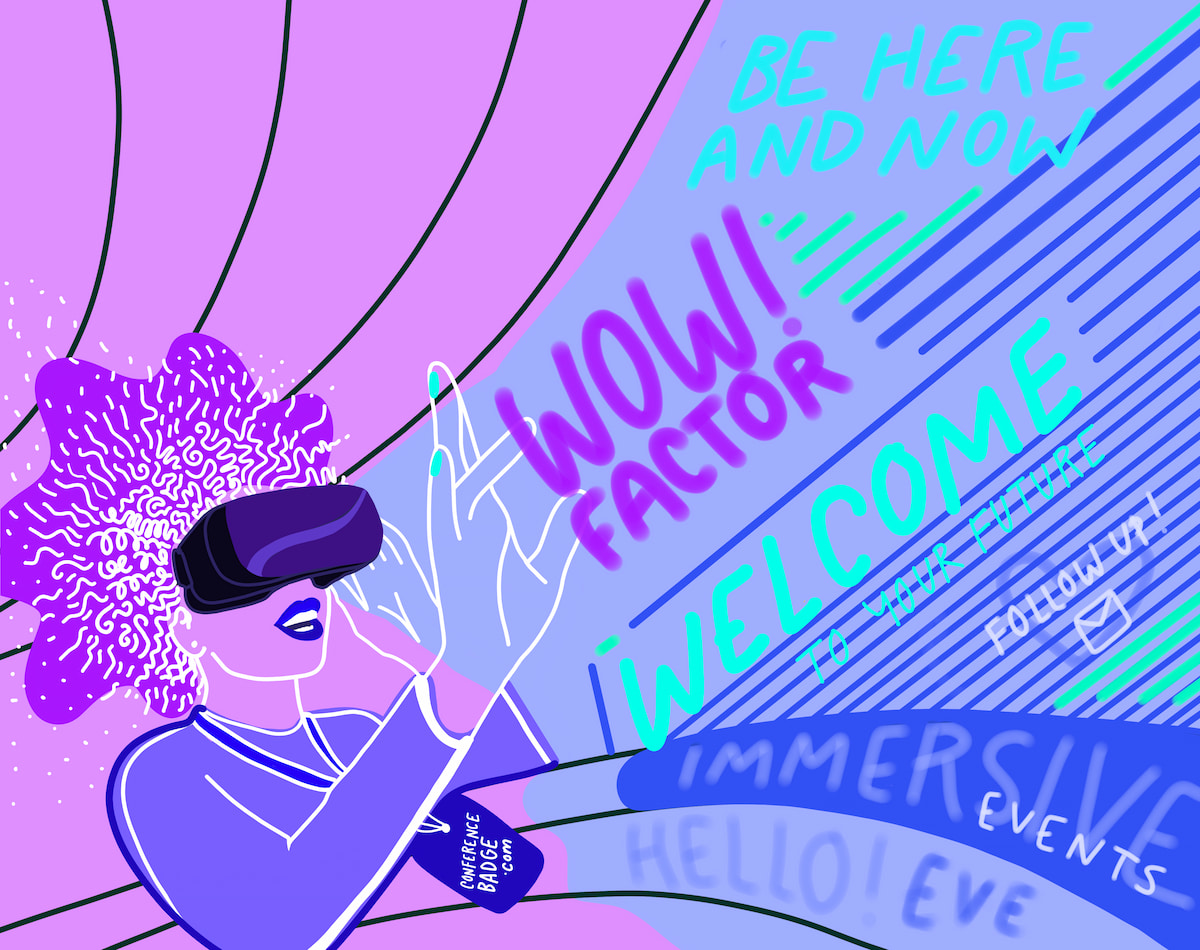Unforgettable And Creative Ideas To Take Your Attendee Experience To The Next Level

Artwork by Mónica Alexis
Gone are the days of conferences where attendees simply sit through presentations and exchange business cards. Instead, today's conference-goers crave an immersive, engaging, and memorable event experience that goes beyond the ordinary.
This article will explore various creative ideas to elevate your event attendee experience to the next level. So, whether you're organizing a large-scale in-person industry event or a niche virtual event, these ideas will empower you to plan an event that stands out from the rest, leaving a lasting impression on attendees and setting the stage for future event success.
Pre-Conference Audience Engagement Ideas
While event planners often dedicate their time to generating ideas for engagement and active participation during the event, allocating efforts toward pre-event preparation is equally important. Here are a few ideas.
1. Build anticipation with personalized invitations and early access
Building anticipation for your SaaS conference starts with great event marketing. First, you want people to be aware of your event, and social media, a newsletter, and sponsorships can help you market the event to your target audience. Then, by creating invitations and badges tailored to each attendee, you make them feel valued and recognized.
When attendees receive their name badges in advance, it serves as a reminder of the upcoming event. Tools like Conference Badge can help you create custom name badges with your branding and the attendee’s information. You can then print and mail out the badges ahead of the event.
Furthermore, early access helps build anticipation, whether granting registered attendees priority registration for preferred sessions or offering sneak peeks of what's to come.

2. Offer exclusive resources to registered attendees
Offering exclusive pre-event content or resources to registered attendees adds value to their conference experience and builds anticipation for the event. For example, you can send newsletters explaining the on-site registration process, past webinars featuring speakers, or share exclusive offers from sponsors.
This shows the event organizers' commitment to delivering high-quality content and sets the stage for an exciting and professional conference experience.
3. Create interactive social media campaigns to engage with attendees
Creating interactive social media campaigns before the event is an excellent way to engage with attendees and generate excitement. Using platforms like Twitter, Facebook, Instagram, or LinkedIn, conference organizers can build community and anticipation among attendees. These campaigns may involve using event-specific hashtags, organizing contests or giveaways, sharing behind-the-scenes content, or conducting live Q&A sessions with speakers or organizers.
By encouraging attendees to participate, share their thoughts, and connect actively, interactive social media campaigns create a buzz around the conference and help build relationships even before the event begins. Additionally, they provide a platform for organizers to share updates, announcements, and valuable resources, ensuring attendees stay informed and engaged.
Unique On-Site Experiences
Creative on-site experiences are crucial to creating a memorable event. These experiences go beyond traditional sessions and presentations, offering attendees interactive and immersive activities that leave a lasting impression.
1. Event app
Having an event app can significantly enhance the attendee experience and boost engagement with the event. By downloading the mobile app, attendees can use it as a powerful tool to get access to information and interactive features. The app can include schedules, session descriptions, speaker profiles, venue maps, and other info. Interactive elements can also be added: live polling, Q&A sessions, and post-event surveys. Send out notifications to inform attendees about essential updates, the following session on their schedule, or invite them to complete surveys.
2. Gamified Activities
Incorporate gamification elements into the conference to make it more interactive and engaging. For example, you can create a scavenger hunt where attendees must complete tasks or find hidden clues throughout the conference venue. Implementing leaderboards, points, or rewards for participation and achievement can further enhance the gamified experience.
3. Immersive Exhibitions
Set up exhibition areas or product showcases that go beyond traditional expo booths. Create immersive environments where attendees can interact with products or services hands-on and experientially. This can involve virtual reality (VR) or augmented reality (AR) experiences, interactive demos, or live simulations that demonstrate the value and functionality of the products being showcased. This can be pricey and time-consuming, but you could partner with local technology businesses or sponsors to create something magical.
4. Engaging Breakout Sessions
Offer breakout sessions that provide unique and interactive formats. This can include panel discussions with audience participation, interactive debates, lightning talks, or interactive brainstorming sessions. Encourage speakers and moderators to facilitate engaging discussions and create opportunities for attendees to share their perspectives, ask questions, and contribute to the conversation.
5. Networking Opportunities
Design networking opportunities that foster meaningful connections among attendees. Consider hosting themed networking sessions, speed networking events, or informal meet-and-greet sessions with industry experts. Create dedicated spaces or lounges where attendees can relax, network, and converse with like-minded professionals.
Post-Conference Engagement Strategies
Post-event engagement strategies are crucial for maintaining momentum and extending the value of the event beyond its duration. These strategies enable continued interaction, knowledge sharing, and networking among attendees.
1. Post-Conference Resources and Materials
Provide attendees with access to valuable post-conference resources and materials. This can include recordings of keynote presentations, session summaries, speaker slide decks, or additional resources related to the conference topics.
2. Online Discussion Forums and Virtual Communities
Establish online discussion forums or virtual communities where attendees can continue the conversations sparked during the conference. These platforms allow participants to share their thoughts, ask questions, and collaborate with fellow attendees. Encourage active participation by assigning moderators to facilitate discussions, answer queries, and keep the conversations engaging and informative.
3. Post-Conference Surveys and Feedback
Conduct post-conference surveys to gather feedback from attendees. Ask about their overall experience, session preferences, and suggestions for improvement. This feedback is invaluable in shaping future events and addressing areas requiring attention. Additionally, consider offering incentives such as exclusive content or discounts on future conferences to encourage participation in the survey.
4. Follow-Up Communication
Maintain regular communication with attendees after the conference. Send follow-up emails thanking them for their participation, sharing highlights from the event, and informing them about upcoming industry news or relevant events. This keeps attendees engaged and fosters community even after the conference has concluded.
Post-conference engagement strategies are vital for nurturing relationships, fostering knowledge exchange, and ensuring long-term value for attendees. By implementing these strategies, you create an ongoing connection with participants and solidify your reputation as a provider of valuable events!
Conference Badge offers an easy-to-use badge creator to take your event to the next level.
